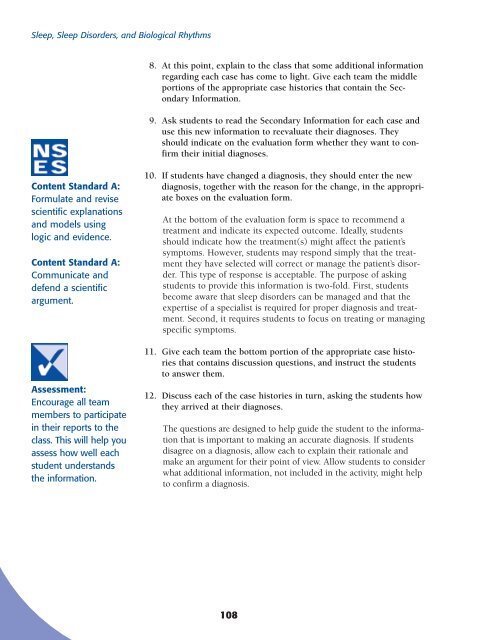Biological - NIH Office of Science Education - National Institutes of ...
Biological - NIH Office of Science Education - National Institutes of ...
Biological - NIH Office of Science Education - National Institutes of ...
Create successful ePaper yourself
Turn your PDF publications into a flip-book with our unique Google optimized e-Paper software.
Sleep, Sleep Disorders, and <strong>Biological</strong> Rhythms<br />
8. At this point, explain to the class that some additional information<br />
regarding each case has come to light. Give each team the middle<br />
portions <strong>of</strong> the appropriate case histories that contain the Secondary<br />
Information.<br />
9. Ask students to read the Secondary Information for each case and<br />
use this new information to reevaluate their diagnoses. They<br />
should indicate on the evaluation form whether they want to confirm<br />
their initial diagnoses.<br />
Content Standard A:<br />
Formulate and revise<br />
scientific explanations<br />
and models using<br />
logic and evidence.<br />
Content Standard A:<br />
Communicate and<br />
defend a scientific<br />
argument.<br />
Assessment:<br />
Encourage all team<br />
members to participate<br />
in their reports to the<br />
class. This will help you<br />
assess how well each<br />
student understands<br />
the information.<br />
10. If students have changed a diagnosis, they should enter the new<br />
diagnosis, together with the reason for the change, in the appropriate<br />
boxes on the evaluation form.<br />
At the bottom <strong>of</strong> the evaluation form is space to recommend a<br />
treatment and indicate its expected outcome. Ideally, students<br />
should indicate how the treatment(s) might affect the patient’s<br />
symptoms. However, students may respond simply that the treatment<br />
they have selected will correct or manage the patient’s disorder.<br />
This type <strong>of</strong> response is acceptable. The purpose <strong>of</strong> asking<br />
students to provide this information is two-fold. First, students<br />
become aware that sleep disorders can be managed and that the<br />
expertise <strong>of</strong> a specialist is required for proper diagnosis and treatment.<br />
Second, it requires students to focus on treating or managing<br />
specific symptoms.<br />
11. Give each team the bottom portion <strong>of</strong> the appropriate case histories<br />
that contains discussion questions, and instruct the students<br />
to answer them.<br />
12. Discuss each <strong>of</strong> the case histories in turn, asking the students how<br />
they arrived at their diagnoses.<br />
The questions are designed to help guide the student to the information<br />
that is important to making an accurate diagnosis. If students<br />
disagree on a diagnosis, allow each to explain their rationale and<br />
make an argument for their point <strong>of</strong> view. Allow students to consider<br />
what additional information, not included in the activity, might help<br />
to confirm a diagnosis.<br />
108

















